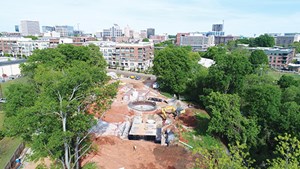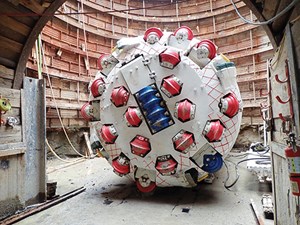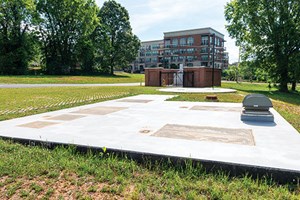January 2023 Vol. 78 No. 1
Features
Digging Deep for Resilience
Katherine Bonamo and Thomas Renner
CITY ON THE UPSWING BUILDS FOR THE FUTURE
(UI) — In recent years, resilience has been much in the news. Individuals are encouraged to prize adaptability. Parents strive to raise children who will trust themselves in adversity. And cities, whose vibrancy has been threatened by the global pandemic, are now seeking ways to bounce back.

Resilience is an essential concept for water infrastructure as well, defined by the American Society of Civil Engineers as “a system’s ability to withstand and adapt to the impacts of natural and/or manmade disasters.” As climate instability increases the likelihood of heavy downpours, sewer systems without ample capacity are increasingly vulnerable to overflow.
In September 2022, for example, rainfall of nearly 5 inches within 24 hours led to overflow conditions in Milwaukee, Wis. Approximately 765 million gallons of wastewater were discharged into Lake Michigan, the Milwaukee River and other local waterways.
In Greenville, S.C., officials have made the smart choice to take the long view. The population of Greenville County, now exceeding half a million residents, has more than doubled since 1970. Rather than wait for a maxed-out sewer system to be overwhelmed by some future storm, regional authorities chose to get out ahead of the growing city’s needs. The Dig Greenville project, also called the Reedy River Basin Sewer Tunnel, cost $46 million and is the largest infrastructure project in the city’s 191-year history.
“Dig Greenville is one of the most important infrastructure investments needed to ensure economic growth in the area,’’ said Graham Rich, chief executive officer of ReWa, the regional water management organization.
Due to this project, “… sewer lines and the area along the Reedy River will be at lower risk for sewer overflows, especially when rainfall is high,” he said. It also ensures “Greenville’s future, economic development since, without it, no additional wastewater flows could be added to the existing lines.”
Deep dive
When seeking the best long-term alternative for the Greenville area, ReWa considered no fewer than 18 different options before settling on a final approach: construction of a new 1.3-mile gravity sewer tunnel.

As the name suggests, gravity sewers rely on careful design to transport waste without the added energy costs of pumping. However, such sewers typically need to be situated far enough below the ground that they can receive gravity flow from all intended sources. Long sewers may also need the depth to allow for a sufficient gradient over their length.
In the case of Dig Greenville, the plan called for installing the new line 100 feet below ground.
“While it is pricier to build, a deep sewer tunnel powered by gravity will be far less costly over its lifecycle for ReWa, while providing the reliable additional capacity Greenville needed as it continues to grow,’ said ReWa CEO Joel Jones, who took over as executive director from Rich earlier this year.
Black & Veatch led the design and provided construction management services. The tunnel is expected to serve the Greenville community for the next century. A major challenge was putting the structure in place – right beneath the heart of a busy downtown.
“We wanted to gain the trust of the community from the very beginning,” said Jones. “We had a series of meetings where we showed the community that we were serious about the concerns and taking them into consideration.”
Steve O’Donnell, Black & Veatch construction manager, held a regular series of open conversations over coffee (“Sippin’ with Steve”), which continued, virtually, when the pandemic intervened. Project planners also strove to limit the degree of disruption for Greenville residents from the outset.
Teams built wooden fencing around the construction to minimize the aesthetic impact. At the Greenville Zoo, located near one end of the new tunnel, ReWa created a new parking lot to offset the temporary loss of other parking spaces, ultimately increasing the zoo’s total parking capacity.
Road closures were largely limited to a two-month winter period, when one roadway was closed off to facilitate quicker construction for a sewer crossing across Richland Creek and to accommodate the city’s streambank restoration program.
But the use of a tunnel boring machine (TBM) for the dig was key to keeping the impact of the project out of sight. If ReWa had chosen to rebuild the existing sewer line, which closely followed the path of the Reedy River basin through Greenville, this would have been a far more disruptive option for city residents, requiring significant trench work.
With a TBM, “The tunnel is bored from one end, resulting in surface impact only at either end of the tunnel, rather than all along the sewer route if conventional construction methods were used,” said Jones.
Seven feet in diameter and approximately 6,000 feet long, the completed sewer is virtually invisible to the public. Entry shafts at each end are the only hint of the massive line under the surface. The pipes are encased in granite, lined with fiberglass and grouted. The gravity-fed system means no mechanical equipment is needed to convey the flow of wastewater.
Bump in the road
The initial plan in Greenville was for subcontractor Super Excavators of Wisconsin to bore the entire tunnel with a double-shielded rock gripper TBM made by Lovsuns Canada, once an access shaft had been created.

Measuring 275 feet (or the length of 17 cars), the TBM used on the project is one of only a handful of similar pieces of equipment in the world. In addition to keeping the work below ground, the TBM was also expected to help shorten the project timeline.
However, Dig Greenville encountered an unforeseen obstacle in this respect: the geology of the tunnel zone.
“The tunnel boring machine can only work through one type of material,’’ Jones noted. “Right when we were getting started, we saw that the granite was not where we thought it was.”
As a result of this complication, construction began with a starter tunnel. Ultimately, 41 separate blasts would be required over a nine-month period, in addition to the hard labor of hand digging at the very outset.
“What we found was about 240 feet of clay and rock that we had to dig out,’’ Jones said.
“It cost us about 10 months of project time. The tunnel boring machine can dig out about 40-50 feet per day. We were only digging out about two feet per day. It was very time- and labor-intensive just to get started.”
Workers also had to fabricate and install a customized steel shield to keep the 14-foot-round starter tunnel secure.
Once the TBM could be put into operation, the project advanced more quickly. After nine months of boring through intact Gneiss bedrock, “Carrie” emerged from the ground on Westfield Street near Greenville’s Kroc Center, having traveled twice under the Reedy River.
By then, the amount of crushed rock removed by the machine would fill 11 Olympic-size swimming pools. And as Joel Jones noted, even with the unexpected delay, Dig Greenville came in within the original project budget.
Out of sight, but key to growth
Despite the scale of the undertaking, the Reedy River Basin Sewer Tunnel is largely invisible to Greenville residents, except for discreet access doors at each end.
The BILCO Company manufactured 13 floor doors of various sizes for the project. The doors allow access to vertical shafts – one is 35 feet deep, the other is 105 feet deep – in which workers will descend, or lower equipment, into the tunnel. BILCO floor doors are designed with engineered lift assistance to ensure safe, easy, door operation.
“We used those types of doors fairly often on our projects, especially at pump stations,’’ Jones said. “We find they have good durability and reliability.”
Greenville’s prudent investment in this critical infrastructure sets the stage for future growth. The work itself may be far below the ground, hidden from view. But in an age when wild weather is no longer the exception, the ongoing prosperity of this charming Southern city will be clear to see. UI
ABOUT THE AUTHORS: Katherine Bonamo and Thomas Renner write on trade industry topics for publications throughout the United States.
FOR MORE INFORMATION:
BILCO Company, (800) 366-6530, bilco.com
Lovsuns Canada, (905) 364-1055, lovsuns.com/
Black & Veatch, (913) 458-2000, bv.com
Project at a Glance
What: Dig Greenville, also known as the Reedy River Basin Sewer Tunnel, is a 1.3-mile gravity-fed sewer line in South Carolina.
Project details: The $46-million project started in 2018 and concluded in 2022. It is the largest infrastructure project in Greenville’s history. The project is expected to support Greenville’s wastewater conveyance needs for the next century.
Why it’s important: The existing sewer line face pressure from increasing population. Without more capacity, the community
would be at risk for overflow.
Digging deep: The tunnel is located as far as 100 feet beneath the surface. Few people will even know it’s there. The only evidence visible are access points at each end. Thirteen floor-access doors manufactured by BILCO enable workers to install, remove and repair equipment.
Did you know? Greenville is sixth in population and growth rate in South Carolina.




Comments